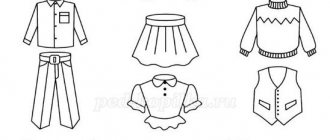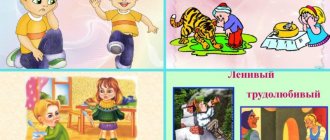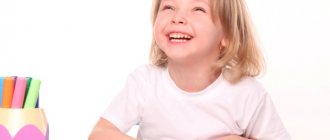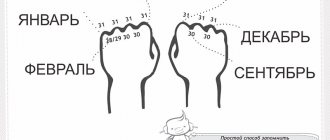Fourth wheel
Target. Development of thinking.
Task. Familiarization with the surroundings (clothes, shoes, hats).
Equipment. Subject pictures with images of clothes, shoes, hats.
Progress of the game
The teacher will put pictures on the typesetting canvas with images of three items of clothing and one pair of shoes or three pairs of shoes and one headdress and invites them to examine and name them. You can invite children to remember poems, nursery rhymes, and riddles about these objects. Then the children are given the task of determining which picture is odd and why.
You can play the game in a similar way by placing on a typesetting canvas three pictures with images of multi-colored clothes and one with images of plain clothes, or three pictures with images of clothes for winter and one picture with images of clothes for summer, etc.
What's missing? Target. Development of visual attention and perception. Task. Familiarization with the surroundings (clothes, shoes, hats).
Equipment. Subject pictures with images of clothes, shoes, hats.
Progress of the game
The teacher will place pictures on the typesetting canvas with images of four to five items of clothing, shoes, and hats, asking them to examine and name them. You can invite children to remember poems, nursery rhymes, and riddles about these objects. Then the children are asked to close their eyes. At this time, the teacher removes one of the pictures. Having opened their eyes, children must determine what is missing.
What changed? Target. Development of visual attention and perception. Task. Familiarization with the surroundings (clothes, shoes, hats).
Equipment. Subject pictures with images of clothes, shoes, hats.
Progress of the game
The teacher will put pictures with images of clothes, shoes, and hats on the typesetting canvas, asking them to look at and name them. You can invite children to remember poems, nursery rhymes, and riddles about these objects. Then the children are asked to close their eyes. At this time, the teacher swaps two pictures or puts another instead of one picture (thin socks instead of woolen socks). Having opened their eyes, children must determine what has changed or which pictures have swapped places.
What appeared? Target. Development of visual attention and perception. Task. Getting to know those around you! (clothes, shoes, hats).
Equipment. Subject pictures with images of clothes, shoes, hats.
Progress of the game
The teacher places pictures with images of four to five items of clothing, shoes, and hats on the typesetting canvas, asking them to examine and name them. You can invite children to remember poems, nursery rhymes, and riddles about these objects. Then the children are asked to close their eyes. At this time, the teacher places another picture on the typesetting canvas. Having opened their eyes, children must determine what object has appeared.
Choose a scheme
Target. Development of sound word analysis skills.
Task. Familiarization with the surroundings (clothes, shoes, hats).
Equipment. Subject pictures with images of a hat, fur coat, jacket, raincoat. Cards with sound patterns of these words.
Progress of the game
The teacher places pictures with images of a hat, fur coat, jacket, and cap on the typesetting canvas. Children look at the pictures and name them. Then the teacher invites the children to take one card with a sound diagram of the word from a bag, chest or container. Children complete the task and then look at the diagrams. Next, they are given the task of putting diagrams under those pictures whose names correspond to the diagrams in terms of sound composition.
Syllabic domino Goal. Improving the skill of syllabic analysis of words.
Equipment. Subject pictures with images of clothes, shoes, hats (scarf, raincoat, fur coat, hat, trousers, dress, leggings, sneakers, mittens, overalls). Cards with images of one, two, three and four squares.
Progress of the game
The teacher will place pictures of clothes, shoes, and hats on the typesetting canvas. Children look at and name them. The teacher puts cards with images of one, two, three and four squares in a row. He explains that the squares represent the number of syllables in the names of objects. Next, children are given the task of arranging pictures with images of clothes, shoes and hats into a square, depending on how many syllables their names are divided into.
How to make cards and pictures of clothes for children
The presented clothing pictures need to be downloaded and printed, if you want to paste them onto cardboard or other thick paper. Cut out the cards and show them to your child in a playful way.
You can play with one child or in a group of children. In this case, tasks for children may be different:
1) name the objects correctly;
2) tell what you can wear with what;
3) which of the items belong to men’s clothing and which to women’s;
4) what is worn in winter, spring, summer, autumn.
The most important thing in communicating with a child is, undoubtedly, the positive attitude of an adult, then learning will be easy and beneficial for the child.
Educational games for children are very different. Children playing educational games train their own thinking, ingenuity, imagination, and creativity.
Preview:
Goals:
Expand children's knowledge about clothing. Enrich children's vocabulary on the topic. Teach children to classify clothes according to a given criterion (winter or summer, women's or men's). Reinforce the concepts of color, size, shape, quantity. Develop thinking, attention, fine motor skills.
Equipment:
Cut-out pictures depicting various clothes. (for convenience and durability, we have them laminated with tape), a box with clothespins, images of a boy and a girl, cardboard strips of different colors (blue, yellow, pink, red, green). Progress of the game:
Option 1: “Name the clothes and their details”
The teacher asks you to select one item of clothing from the box and name the details (collar, pocket, hood, buttons, etc.)
Option 2 “Clothes for boys and girls”
The mother washed her son and daughter's clothes and asked them to carefully hang their clothes to dry using clothespins. Show your son, daughter. Girls' clothes should be hung on pink stripes, boys' clothes should be hung on blue stripes. Help children hang their clothes correctly.
Option 3 “Seasonal clothes”
Let's use clothespins to attach clothes that can be worn in summer (winter, spring, autumn) to colored stripes.
Attach winter clothes to the blue stripe, summer clothes to the red stripe, autumn clothes to the yellow stripe, and spring clothes to the green stripe. For each strip from one to three items of clothing. How many did you get on your strip of clothing? Who is this clothing for - a boy or a girl? What colour?
How to conduct lessons with your child using cards
When studying new pictures, you need to correctly name what is shown on the card, tell what it is, what it is used for. You can even play the game find the object. For example, collect some objects in the house, show them on a card, and then invite the child to find it in a pile of things. The child will really like this game, and you will spend your time usefully and happily.
Here are educational cards for children “Items of clothing” containing pictures of clothing for children from 36 items.





